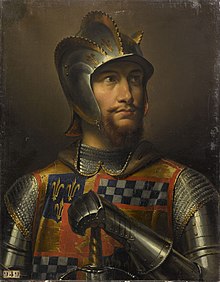John Stewart, Earl of Buchan
This article includes a list of general references, but it lacks sufficient corresponding inline citations. (January 2011) |
John Stewart | |
|---|---|
| Earl of Buchan | |
 19th-century painting of Stewart | |
| Born | c.1381 Scotland |
| Died | 17 August 1424 Verneuil-sur-Avre, France |
| Wars and battles |
|
| Offices | Hundred Years War . |

John Stewart, Earl of Buchan (c. 1381 – 17 August 1424) was a Scottish nobleman and soldier who fought alongside the
However, two years later, Stewart was defeated and captured by an English force led by
Early life
Stewart was born c.1381, the son of
Family
Stewart married Elizabeth Douglas (1385x1401–c.1451), daughter of
Hundred Years War
In 1419 Stewart's father sent him to France with an army of 6,000 men to fight in the
Baugé was a huge boost to the morale of the Scottish and French, proving that the English were not invincible. On hearing of the Franco-Scottish victory, Pope Martin V remarked that "the Scots are well-known as an antidote to the English."
Capture and ransom

In the early summer of 1423, at the
For three hours the forces stared each other down, neither willing to attempt an opposed river crossing. Salisbury finally took the initiative and his army began to cross the waist-high river, some 50 metres wide, under a covering hail of arrows from English archers. Meanwhile, another English force under Baron Willoughby de Eresby forced a passage through the Scots across the narrow bridge and divided the Dauphin's army.
When the French ranks began to withdraw, the Scots refused to flee and were cut down by the hundreds. Over 3,000 of them fell at the bridgehead or along the riverbanks, and over 2,000 prisoners were taken, including the Earl of Buchan and the commander of the Dauphin's forces, the
After the battle Buchan was exchanged, and after his release in 1424 he was appointed Constable of France making him the effective Commander-in-Chief of the French army. To recover from the losses sustained at Cravant, fresh troops under the Earl of Douglas were dispatched from Scotland to France.[2]
Battle of Verneuil

However, despite these welcome reinforcements, disaster would soon overtake Stewart and his Scottish army. On 17 August 1424 Buchan was killed at the
Verneuil was one of the bloodiest battles of the
Legacy
Stewart's death had important consequences for domestic politics in Scotland. His death fatally weakened the position of his brother Murdoch Stewart, Duke of Albany, who was soon afterwards arrested and executed by James I of Scotland, leading to the almost complete ruin of the Albany Stewarts.[6]
A bust of Stewart is displayed to this day in the
See also
Notes
- ^ Mackie, p. 88
- ^ a b c d Mackie, p. 94
- ^ Galt, John, p. 354, Letters from the Levant: containing views of the state of society (1813) Retrieved February 2011
- ^ Mackie, p. 91
- ^ Brougham, Henry, p. 257, History of England and France under the House of Lancaster (1855) Retrieved February 2011
- ^ Brown M. H., John Stewart, ODNB
References
- Chevalier, Bernard, "Les Alliés écossais au service du roi de France au XVe siècle" in James Laidlaw (ed.), The Auld Alliance: France and Scotland over 700 years. Edinburgh University, Edinburgh, 1999. ISBN 0-9534945-0-0
- Brougham, Henry, History of England and France under the House of Lancaster (1855) Retrieved February 2011
- Galt, John, Letters from the Levant: containing views of the state of society (1813) Retrieved February 2011
- Mackie, J. D., A History of Scotland, Penguin Books, London (1964).
- Vale, Malcolm Graham, Charles VII (1974) Retrieved February 2011
